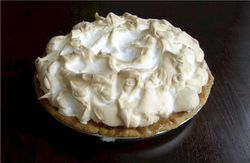A go-to vegan recipe, this lemon meringue pie is based with shortcrust pastry and filled with lemon curd, topped with soft vegan meringue that’s made without using eggs.
With lemon meringue pie, or meringue pies with different fillings, dating back to at least the early 18th century, the exact origin of the dish is unknown, but it’s generally considered a French invention while particularly popular in the UK and United States.
As well as being both vegan and easy to make at home, this vegan lemon meringue pie recipe is fairly adaptable. If lemon isn’t your thing, raspberry is a simple and suitable substitute. For this, you’ll need raspberries, a lime, and a tablespoon of cornflour (see recipe notes).
When making this vegan lemon meringue pie, it’s also advisable to make the pastry well in advance. As well as needing to be chilled after being both made and rolled, the pastry needs to cool completely before the filling is added. The whole dish can be made at once, but will be unnecessarily time consuming, while the cooling can be done at another time without any supervision necessary. The curd can also be made in advance, but making the meringue just before assembly is absolutely crucial.
To make the lemon curd filling, cashews and lemon juice are blitzed in a blender then warmed with lemon zest, then thickened with cornflour and coloured with a tiny pinch of ground turmeric.
To make the vegan meringue, aquafaba (the water from a tin of chickpeas) is beaten with just a dash of white wine vinegar until the mixture resembles stiff peaks. Sugar is then whisked in, one tablespoon at a time, before the pie is topped with the meringue and finished under the grill (or with a blowtorch, if you have one to hand). Ideally let the pie sit for an hour before serving, to stabilise the meringue.

Vegan Lemon Meringue Pie
Equipment
- Tart tin
- Baking beans or rice (or suitable alternative)
- Large mixing bowl
- Stand mixer or electric whisk (not essential, but highly recommended)
- Piping bag (optional)
Ingredients
For the pastry
- 180 g plain flour
- 1 tbsp caster sugar
- 60 ml neutral oil
For the filling (see notes)
- 80 g cashews soaked in boiling water for 15mins
- Pinch of ground turmeric
- 2 tsp cornflour
- 4 tbsp caster sugar
- 120 ml fresh lemon juice
- 2 lemons zest only
For the meringue
- 120 ml aquafaba chickpea water
- 125 g caster sugar
- ½ tsp white wine vinegar
Instructions
- To make the pastry combine flour and sugar in a large bowl. Add the oil and rub it into the dry ingredients with your hands. Finally, add water gradually until a rough dough forms. You should be able to pinch a piece of dough and it should hold its shape. Wrap it in a piece of cling film and chill in the fridge for 30 mins.
- Once chilled, roll out the pastry between two sheets of baking paper until you get a rough circle around 2 mm in thickness (this makes the dough easier to work with). Place the rolled-out dough over the tart tin and trim any excess pastry and crimp if desired. Dock the pastry by pricking the pastry over the bottom with a fork. Chill for 30mins and preheat the oven to 175C /Gas 4.
- While the pastry is chilling, prepare the filling (see notes for raspberry filling instructions). Rinse the soaked cashews and place in a blender with the lemon juice and sugar. Blitz several times until you get a completely smooth liquid.
- Pour cashew and lemon mixture into a small saucepan and add the lemon zest. Warm the mixture gently stirring constantly so it doesn’t burn. Taste the mixture and add more sugar if necessary. Mix the cornflour with 1 tbsp of water in a small bowl and add this to the warm lemon curd. Gently bring the mixture to the boil (stirring the whole time) and allow it to bubble for two minutes to let it thicken (the mixture will thicken further as it cools).
- Finally, add a pinch of salt and a pinch of ground turmeric to give the curd a pale yellow colour, this can be overpowering so add a tiny pinch.
- Line the pastry shell with baking paper and fill with baking beans. Blind bake the pastry for 20 mins, then remove the beans and bake for another 15 mins. Cool pastry down completely before filling.
- Make the meringue just before assembling the pie. In a large, clean bowl (make sure there is no greasy residue, it is best to use a glass or metal bowl for this) beat aquafaba and vinegar with an electric whisk or use a stand mixer until you get stiff peaks. To test if whipped aquafaba is ready, gently turn the bowl upside down. If the mixture does not start sliding down, you can start adding sugar. Otherwise, keep on whipping until the mixture stays in the bowl when inverted. Add the sugar a tablespoon at a time, whipping well after each addition. The mixture should be sticky and glossy when the sugar has been incorporated.
- To assemble, fill the pastry with your chosen filling. Pipe meringue on top using a piping bag (again needs to be completely grease-free), alternatively spoon on the meringue and shape into swirls. Toast the meringue under a hot oven grill for a few minutes watching closely as it can burn very quickly. The pie may also need rotating after a minute to brown evenly. Alternatively, you can use a blow torch.
- Let meringue pies stand for at least an hour after toasting the meringue so that it stabilises.
Notes
Related: How To Make: Plant Nut Roast with Cavolo Nero and Apple

